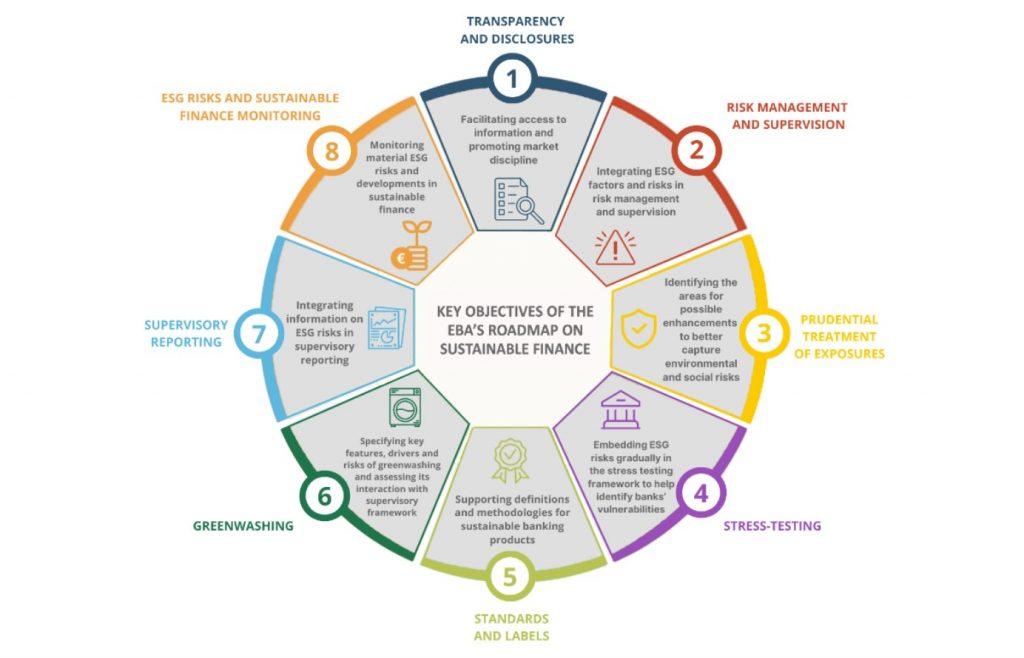Main Achievements on ESG Roadmap
The European Banking Authority (EBA) presents main achievements on ESG roadmap, aiming to conclude the various actions carried out in the past year.
The European Banking Authority has released an ESG roadmap in 2022 to make plans for the next three years, ultimately integrating ESG risks into the banking regulatory framework and supporting the EU’s transition to a sustainable economy.
Related Post: EBA Releases Sustainable Finance Roadmap

Introduction to EBA’s ESG Roadmap
The second version of the ESG roadmap released by the European Banking Authority formulated a work plan from 2023 to 2025. Compared with the first version of the ESG roadmap from 2020 to 2022, the new version of the ESG roadmap has formulated eight goals, which are:
- Transparency and disclosures: Strengthen access to information and establish market rules.
- Risk management and supervision: Incorporate ESG factors and risks into the risk management framework.
- Prudential treatment of exposures: Identify areas for improvement to better measure environmental and social risks.
- Stress testing: Incorporate ESG risks into the stress testing framework to help banks identify weaknesses.
- Standards and labels: Support definitions and methods for establishing sustainable banking products.
- Greenwashing: Describe the characteristics, drivers and risks of greenwashing, and assess the interaction with regulatory framework.
- Supervisory reporting: Add ESG risk to supervisory reports.
- ESG risks and sustainable finance monitoring: Track developments in material ESG risks and sustainable finance.
EBA’s Actions Based on ESG Roadmap
In line with the work objectives of the ESG Roadmap, the European Banking Authority continues to improve the prudential risk framework to measure environmental and social risks. In October 2023, the European Banking Authority issued a report on the role of environmental and social risks in the prudential framework of credit institutions and investment companies, assessing how to include environmental and social risks in the prudential framework and as part of the implementation of the revised Capital Requirements Regulation and Capital Requirements Directive (CRR III / CRD VI).
In terms of ESG risk management and supervision, in January 2024, the European Banking Authority released a consultation document on the draft ESG risk management guidelines, and plans to formulate measures for the banking industry to identify, measure, manage and detect ESG risks this year. In terms of ESG information disclosure, the European Banking Authority reviewed the Principal Adverse Impact (PAI) and financial disclosure rules in the European Sustainable Finance Disclosure Regulation (SFDR), and published a report in September 2023.
In order to promote the development of sustainable finance in the EU, the European Banking Authority, the European Securities and Markets Authority (ESMA) and the European Insurance and Occupational Pensions Authority (EIOPA) released reports on greenwashing in the financial sector within their respective areas of responsibility in June 2023. The report released by the European Banking Authority outlines the phenomenon of greenwashing in the banking industry and its impact on credit institutions and investment companies.
The European Banking Authority also responded to the European Commission’s consultation paper on green loans and mortgages. A report released by the European Banking Authority in December 2023 recommends setting up a voluntary green loan label and establishing green loan standards and incorporating them into the EU Mortgage Credit Directive.
European Banking Authority is also preparing a Fit-for-55 climate risk scenario analysis. The climate risk scenario analysis aims to assess the climate resilience of the financial sector and understand the ability of the financial system to support the transition to a low-carbon economy. The European Banking Authority is also considering developing a framework for regular climate stress testing to monitor ESG risks in the banking sector and financial markets.
Reference:








